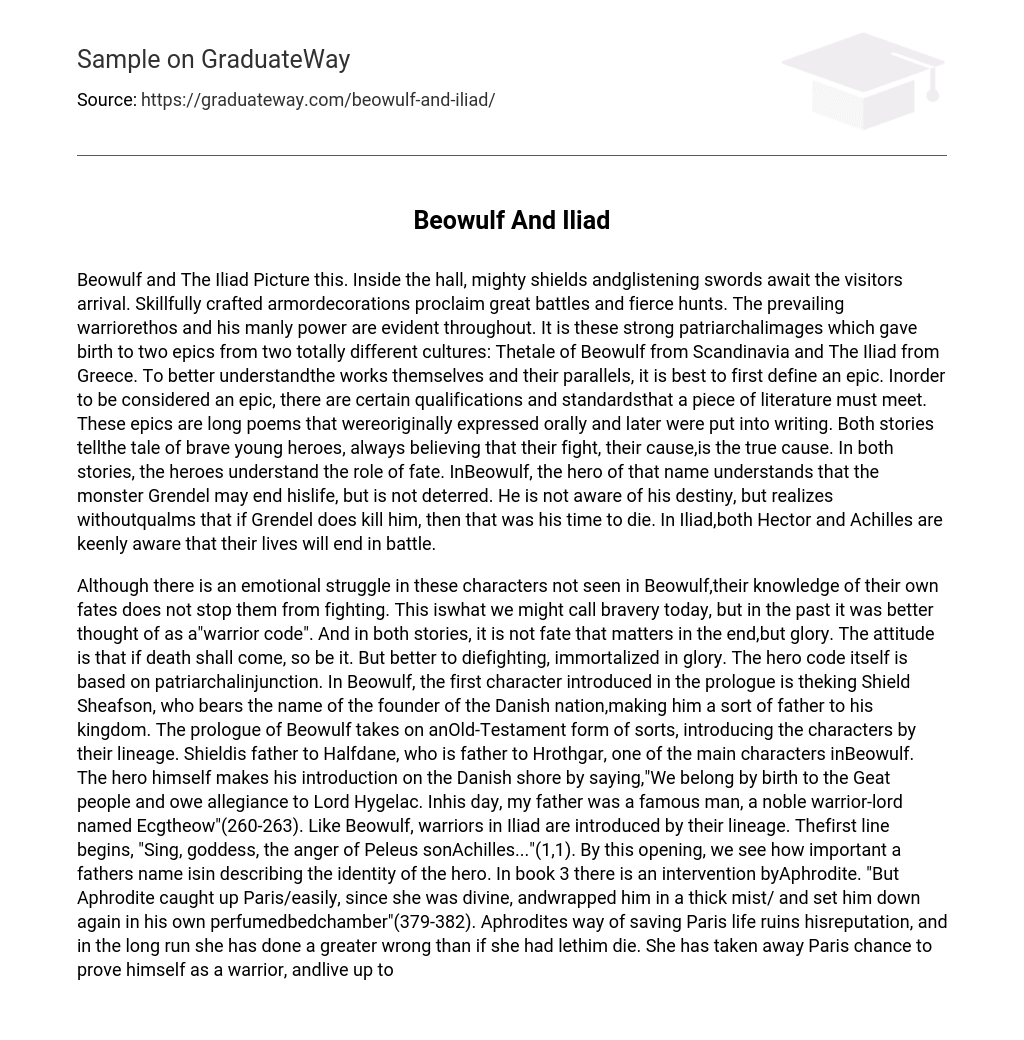Beowulf and The Iliad Picture this. Inside the hall, mighty shields andglistening swords await the visitors arrival. Skillfully crafted armordecorations proclaim great battles and fierce hunts. The prevailing warriorethos and his manly power are evident throughout. It is these strong patriarchalimages which gave birth to two epics from two totally different cultures: Thetale of Beowulf from Scandinavia and The Iliad from Greece. To better understandthe works themselves and their parallels, it is best to first define an epic. Inorder to be considered an epic, there are certain qualifications and standardsthat a piece of literature must meet. These epics are long poems that wereoriginally expressed orally and later were put into writing. Both stories tellthe tale of brave young heroes, always believing that their fight, their cause,is the true cause. In both stories, the heroes understand the role of fate. InBeowulf, the hero of that name understands that the monster Grendel may end hislife, but is not deterred. He is not aware of his destiny, but realizes withoutqualms that if Grendel does kill him, then that was his time to die. In Iliad,both Hector and Achilles are keenly aware that their lives will end in battle.
Although there is an emotional struggle in these characters not seen in Beowulf,their knowledge of their own fates does not stop them from fighting. This iswhat we might call bravery today, but in the past it was better thought of as a”warrior code”. And in both stories, it is not fate that matters in the end,but glory. The attitude is that if death shall come, so be it. But better to diefighting, immortalized in glory. The hero code itself is based on patriarchalinjunction. In Beowulf, the first character introduced in the prologue is theking Shield Sheafson, who bears the name of the founder of the Danish nation,making him a sort of father to his kingdom. The prologue of Beowulf takes on anOld-Testament form of sorts, introducing the characters by their lineage. Shieldis father to Halfdane, who is father to Hrothgar, one of the main characters inBeowulf. The hero himself makes his introduction on the Danish shore by saying,”We belong by birth to the Geat people and owe allegiance to Lord Hygelac. Inhis day, my father was a famous man, a noble warrior-lord named Ecgtheow”(260-263). Like Beowulf, warriors in Iliad are introduced by their lineage. Thefirst line begins, “Sing, goddess, the anger of Peleus sonAchilles…”(1,1). By this opening, we see how important a fathers name isin describing the identity of the hero. In book 3 there is an intervention byAphrodite. “But Aphrodite caught up Paris/easily, since she was divine, andwrapped him in a thick mist/ and set him down again in his own perfumedbedchamber”(379-382). Aphrodites way of saving Paris life ruins hisreputation, and in the long run she has done a greater wrong than if she had lethim die. She has taken away Paris chance to prove himself as a warrior, andlive up to the paternal injunction. Although Homer presents these characterswhich are opposing the heroic code, these counter-voices are only vehicles bywhich the making of the hero is solidified. However, Beowulf also has characterswho do not abide by or live by the paternal warrior ways. Unferth, for example,is a low man who does not sit high with the warriors, but crouches at thekings feet. He is a jealous Iago who does not rejoice at Beowulfspresence. “Unferth, a son of Ecglafs spoke contrary words. Beowulfscoming, his sea-braving, made him sick with envy” (500-502). In this respect,Unferth is as foolish as Aphrodite and as spoiled as Paris. King Hrothgar isperhaps the closest comparison to Agamemmnon. Both seem to watch as their men doall the fighting (and all the dying). Although Hrothgar has done well at keepinghis people loyal, he does not live up to the warrior code and is seen assomething less than heroic. Beowulf and Achilles learn to keep their soldiersloyal, and how to inspire them in battle. After Agamemmnon is forced to returnhis trophy bride to her father, the priest, he takes the bride of Achilles, lesthe be without spoils to show his greatness in battle. Achilles is unwillinglydishonored by his own leader, thus creating a niche in his warrior reputation.
Achilles, in retribution, refuses to fight. Without his leadership in battleHectors forces quickly subdue the Greek army. There are both similarities andstriking differences in Beowulf and Iliad on the role of women. In Beowulf, themost striking female character is Grendels mother, a monster like her son.
She comes out of the hills to avenge her sons death, and is killed by thehero. In Iliad, there are plenty of female characters. Helen, Aphrodite,Minerva, and Juno (Hera) are the most frequently mentioned ones. The mortalwomen fought over, both Helen and the trophy-bride of Achilles. However, theGoddesses seem to always be tricking and going against both armies, and are morelike pests than deities. These examples of the womans role in ancientliterature provide a decent picture of how women were seen in the eyes ofwarriors: monsters, pests and prizes. This goes back and places even moreemphasis on where the role of the patriarch. Paternal injunction is the cause ofreadiness and fearlessness before death, with which the warriors go to war.
Identification with the father and the fathers name is the effect of thepatriarchal society, which created two masterpieces of ancient literature,Beowulf and the Iliad.





